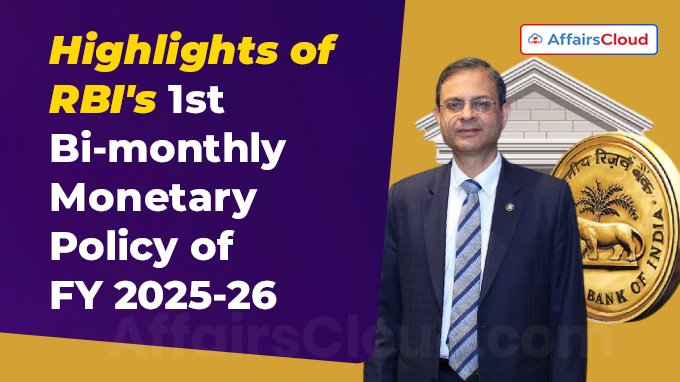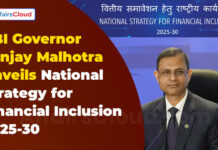 The Reserve Bank of India (RBI) Monetary Policy Committee (MPC) held its 54th meeting from April 7 to 9, 2025 under the chairmanship of Shri Sanjay Malhotra, Governor, Reserve Bank of India.
The Reserve Bank of India (RBI) Monetary Policy Committee (MPC) held its 54th meeting from April 7 to 9, 2025 under the chairmanship of Shri Sanjay Malhotra, Governor, Reserve Bank of India.
- The meeting was attended by the MPC members Dr. Nagesh Kumar, Shri Saugata Bhattacharya, Prof. Ram Singh, Dr. Rajiv Ranjan, and Shri M. Rajeshwar Rao.
- The committee revised the Gross Domestic Product (GDP) growth projection for FY 2025-26 (FY26) to 6.5% from 6.7%.
Key highlights:
i.The committee unanimously decided to:
Reduce the policy repo rate by 25 basis points to 6.00 per cent with immediate effect.
ii.Consequently, the standing deposit facility (SDF) rate under the liquidity adjustment facility (LAF) was adjusted to 5.75 per cent and the marginal standing facility (MSF) rate and the Bank Rate were set to 6.25 per cent.
iii.RBI projected real GDP growth for FY26 for Quarter 1 (Q1: April-June 2025) at 6.5 per cent; Q2 (July-September 2025) at 6.7 per cent; Q3 (October-December 2025) at 6.6 per cent; and Q4 (January-March 2026) at 6.3 per cent.
iv.RBI also decided to change the stance from neutral to accommodative as moderate growth outlook demanded that the MPC continues to support growth.
RBI’s Policy Rate:
| Category | Rate |
|---|---|
| Repo Rate | 6.00% |
| Reverse Repo Rate | 3.35% |
| SDF | 5.75% |
| MSF | 6.25% |
| Cash Reserve Ratio | 4.00% |
| Statutory Liquidity Ratio | 18.00% |
| Bank Rate | 6.25% |
RBI’s Inflation Projection:
The medium-term target for consumer price index (CPI) inflation of 4 per cent within a band of +/- 2 per cent.
i.CPI inflation for the financial year 2025-26 is projected at 4.0 per cent, with Q1 at 3.6 per cent; Q2 at 3.9 per cent; Q3 at 3.8 per cent; and Q4 at 4.4 per cent.
ii.Core inflation, which remained steady in December 2024-January 2025, inched up to 4.1 per cent in February 2025, driven primarily by a sharp pick-up in gold prices.
RBI to enable securitisation of stressed assets through a market-based mechanism:
i.Securitisation involves pooling of loans and selling them to a special purpose entity (SPE), which then issues securities backed by the loan pool.
ii.Currently, securitisations of Non-Performing Assets (NPAs) can be undertaken only by Asset Reconstruction Companies (ARCs) licensed under the Securitisation and Reconstruction of Financial Assets and Enforcement of Security Interest Act, 2002 (SARFAESI) Act.
iii.Based on market feedback and stakeholder consultations, RBI decided to enable securitisation of NPAs through the SPE route, on the lines of securitisation of standard assets. With this objective, RBI had released a discussion paper on Securitisation of Stressed Assets Framework in January 2023.
iv.After factoring in the suggestions received from the stakeholders on the discussion paper, the draft framework for securitisation of stressed assets is being issued for public comments.
RBI expands co-lending framework beyond banks- Non-Banking Financial Company (NBFCs) and priority sector loans:
i.The purpose of “Co-Lending Model” (CLM), is to improve the flow of credit to the unserved and underserved sector of the economy and make available funds to the ultimate beneficiary at an affordable cost, considering the lower cost of funds from banks and greater reach of the NBFCs.
ii.Now, the RBI announced a significant expansion of its co-lending framework, which was previously limited to arrangements between banks and NBFCs for priority sector loans only.
iii.The new policy will extend co-lending arrangements to all regulated entities and all loan categories.
RBI issues draft guidelines on gold loan, aims to put in place a ‘harmonised’ framework:
i.The revised guidelines aim to create a more principle-based and harmonised framework for all Regulated Entities (REs), ensuring consistency in practices related to lending against gold collateral.
ii.They also seek to address prudential risks and conduct-related gaps, promoting sound risk management and fair treatment of customers
RBI issues draft revised norms for Non-Fund Based (NFB) Credit Facilities:
i.The RBI has issued draft directions to streamline and regulate NFB credit facilities, such as guarantees and letters of credit, across all regulated entities (REs) including commercial banks, cooperative banks, All India Financial Institutions, and NBFCs.
ii.The proposed guidelines aim to establish a consistent framework for the issuance and management of NFB exposures.
iii.REs will issue an NFB facility only on behalf of a customer having a business relationship with them. The customer must be availing of a funded credit facility or a deposit facility from the RE.
Enhancing transaction limits in UPI:
i.At present, the transaction amount for UPI, covering both Person to Person (P2P) and Person to Merchant payments (P2M), is capped at Rs.1 lakh except for specific use cases of P2M payments which have higher limits, some at Rs.2 lakh and others at Rs.5 lakh.
ii.It is proposed that NPCI, in consultation with banks and other stakeholders of the UPI ecosystem, may announce and revise such limits based on evolving user needs.
iii.Also, appropriate safeguards will be put in place to mitigate risks associated with higher limits.
RBI to ensure proactive risk management at banks to prevent frauds:
i.The deputy governor Swaminathan J mentioned that, the RBI to ensure that the fraud risk management and proactive risk management system, which are operational at the bank level, are improvised so that frauds can be prevented.
ii.He also added that the pilots of the MuleHunter AI were successful with the large banks and the models were proved effective too.
RBI rules out risk weight reduction on unsecured loans:
i.The RBI clarified it is not promoting uncollateralized lending to boost credit or consumption. Instead, it emphasized that the higher risk weights on unsecured loans, reinstated in November 2023, are simply a return to pre-COVID prudential norms.
ii.RBI Governor Sanjay Malhotra highlighted the need for a clear risk distinction between secured and unsecured loans, maintaining a 25 basis point difference between the two.
RBI launches verified WhatsApp channel to spread financial awareness:
i.The RBI is expanding its ‘RBI Kehta Hai’ public awareness initiative by using WhatsApp to share important financial information.
ii.Through its verified WhatsApp account, the RBI aims to deliver messages in a simple and direct way, making financial awareness more accessible across the country.
Important Definitions:
Repo rate: It is the interest rate at which the Reserve Bank of India (RBI) lends money to commercial banks for short-term needs, against government securities.
Reverse Repo rate: It is the interest rate at which the Reserve Bank of India (RBI) borrows money from commercial banks, usually for short durations.
Cash Reserve Ratio: It is the percentage of a bank’s total deposits that it must be kept as reserves with the RBI in the form of cash form.
Statutory Liquidity Ratio: It is the minimum percentage of a bank’s net demand and time liabilities (NDTL) that it must maintain in the form of liquid assets — like cash, gold, or government-approved securities.
MuleHunter AI:It is an artificial intelligence and machine learning (AI/ML) model, developed by the Reserve Bank of India Innovation Hub (RBIH), a subsidiary of RBI, which helps banks and financial institutions detect mule accounts amid rising concern in the ecosystem around fraud enabled through these accounts.




